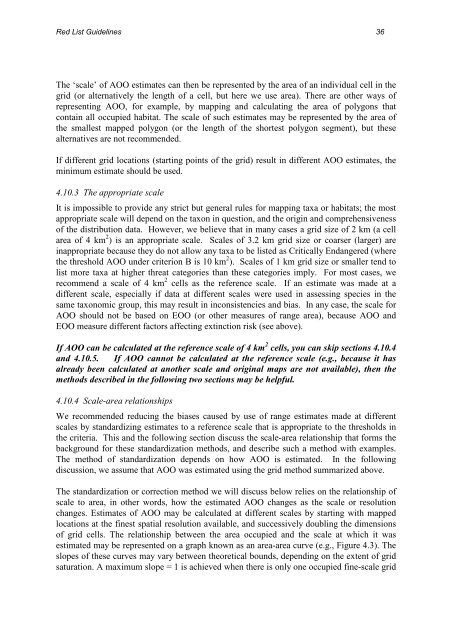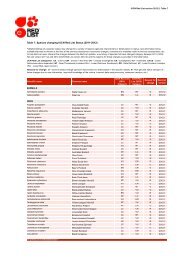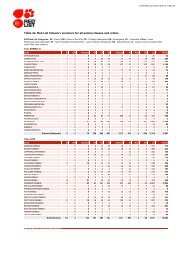IUCN Red List Guidelines - The IUCN Red List of Threatened Species
IUCN Red List Guidelines - The IUCN Red List of Threatened Species
IUCN Red List Guidelines - The IUCN Red List of Threatened Species
You also want an ePaper? Increase the reach of your titles
YUMPU automatically turns print PDFs into web optimized ePapers that Google loves.
<strong>Red</strong> <strong>List</strong> <strong>Guidelines</strong> 36<br />
<strong>The</strong> ‘scale’ <strong>of</strong> AOO estimates can then be represented by the area <strong>of</strong> an individual cell in the<br />
grid (or alternatively the length <strong>of</strong> a cell, but here we use area). <strong>The</strong>re are other ways <strong>of</strong><br />
representing AOO, for example, by mapping and calculating the area <strong>of</strong> polygons that<br />
contain all occupied habitat. <strong>The</strong> scale <strong>of</strong> such estimates may be represented by the area <strong>of</strong><br />
the smallest mapped polygon (or the length <strong>of</strong> the shortest polygon segment), but these<br />
alternatives are not recommended.<br />
If different grid locations (starting points <strong>of</strong> the grid) result in different AOO estimates, the<br />
minimum estimate should be used.<br />
4.10.3 <strong>The</strong> appropriate scale<br />
It is impossible to provide any strict but general rules for mapping taxa or habitats; the most<br />
appropriate scale will depend on the taxon in question, and the origin and comprehensiveness<br />
<strong>of</strong> the distribution data. However, we believe that in many cases a grid size <strong>of</strong> 2 km (a cell<br />
area <strong>of</strong> 4 km 2 ) is an appropriate scale. Scales <strong>of</strong> 3.2 km grid size or coarser (larger) are<br />
inappropriate because they do not allow any taxa to be listed as Critically Endangered (where<br />
the threshold AOO under criterion B is 10 km 2 ). Scales <strong>of</strong> 1 km grid size or smaller tend to<br />
list more taxa at higher threat categories than these categories imply. For most cases, we<br />
recommend a scale <strong>of</strong> 4 km 2<br />
cells as the reference scale. If an estimate was made at a<br />
different scale, especially if data at different scales were used in assessing species in the<br />
same taxonomic group, this may result in inconsistencies and bias. In any case, the scale for<br />
AOO should not be based on EOO (or other measures <strong>of</strong> range area), because AOO and<br />
EOO measure different factors affecting extinction risk (see above).<br />
If AOO can be calculated at the reference scale <strong>of</strong> 4 km 2<br />
cells, you can skip sections 4.10.4<br />
and 4.10.5. If AOO cannot be calculated at the reference scale (e.g., because it has<br />
already been calculated at another scale and original maps are not available), then the<br />
methods described in the following two sections may be helpful.<br />
4.10.4 Scale-area relationships<br />
We recommended reducing the biases caused by use <strong>of</strong> range estimates made at different<br />
scales by standardizing estimates to a reference scale that is appropriate to the thresholds in<br />
the criteria. This and the following section discuss the scale-area relationship that forms the<br />
background for these standardization methods, and describe such a method with examples.<br />
<strong>The</strong> method <strong>of</strong> standardization depends on how AOO is estimated. In the following<br />
discussion, we assume that AOO was estimated using the grid method summarized above.<br />
<strong>The</strong> standardization or correction method we will discuss below relies on the relationship <strong>of</strong><br />
scale to area, in other words, how the estimated AOO changes as the scale or resolution<br />
changes. Estimates <strong>of</strong> AOO may be calculated at different scales by starting with mapped<br />
locations at the finest spatial resolution available, and successively doubling the dimensions<br />
<strong>of</strong> grid cells. <strong>The</strong> relationship between the area occupied and the scale at which it was<br />
estimated may be represented on a graph known as an area-area curve (e.g., Figure 4.3). <strong>The</strong><br />
slopes <strong>of</strong> these curves may vary between theoretical bounds, depending on the extent <strong>of</strong> grid<br />
saturation. A maximum slope = 1 is achieved when there is only one occupied fine-scale grid






